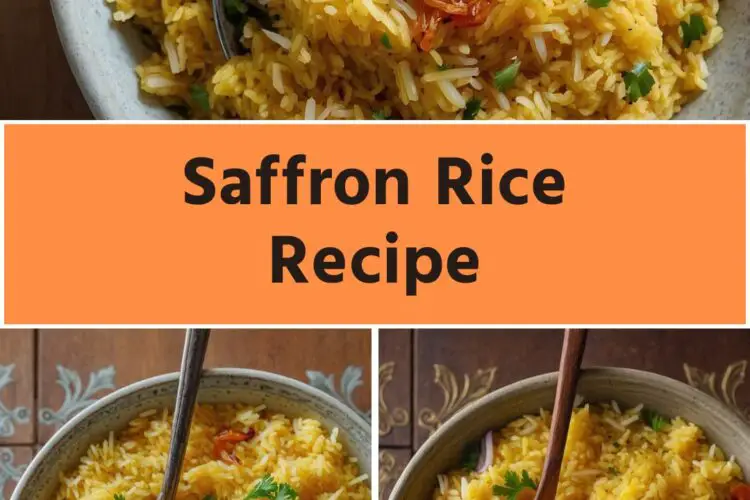Before we dive into the culinary journey of saffron rice, let’s chat about pairing. This vibrant dish shines when you complement it well. Serving saffron rice with grilled chicken or shrimp enhances its richness. It can also accompany roasted vegetables or lentil stew, creating a balanced meal. Want to impress? Pair it with a tangy yogurt sauce, or a refreshing salad, such as tabbouleh or a simple cucumber-tomato combo.
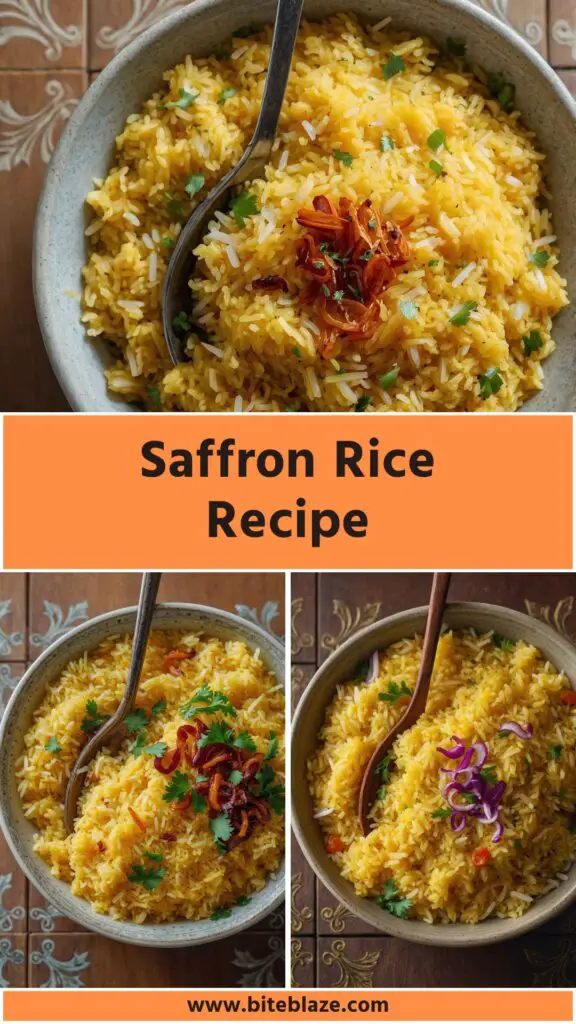
Welcome to my saffron rice adventure! I stumbled upon this captivating dish while exploring cuisines that celebrate spices. With its golden hue and aromatic charm, saffron rice is not just food; it’s an experience. Picture a dinner scene filled with laughter, colors, and the enchanting scent of saffron wafting through the air. You can almost feel the warmth from a sun-kissed evening, surrounded by friends and family. Isn’t that what we aspire to create at the dining table?
What is Saffron Rice?
Saffron rice is a classic dish originating from various cultures, primarily found in Middle Eastern, Indian, and Mediterranean cuisines. As its name suggests, saffron is the star ingredient that transforms plain rice into a luxurious dish. Known for its distinctive yellow color and unique flavor, saffron adds not just visual appeal but also a depth of taste that is hard to resist.
The rice used in this dish is typically basmati, known for its long grains that have a light, fluffy texture. This combination of saffron and basmati creates a melody of flavors and aromas that can turn a simple meal into a culinary masterpiece.
You will also like the following Lunch and Dinner recipes!
- The Best Crock Pot Teriyaki Chicken
- Copycat Thai Turkey Meal Prep Lettuce Wraps
- Honey Garlic Chicken Marinade Sauce
What is the Flavor Profile of This Dish?
Imagine biting into a fluffy grain of rice, which has absorbed a touch of the Middle East’s warmth. The flavor profile of saffron rice is rich and layered. The base is slightly nutty, thanks to the basmati rice, while the saffron infuses a unique combination of floral and earthy notes.
When you add gentle hints of garlic and onion, you create a delicious foundation that enhances the saffron. A dash of cumin gives it an unexpected warmth, balancing the dish beautifully, while a squeeze of lime adds a refreshing zest that brightens every bite.
Why You’ll Love This?
Now, let’s break it down. Why should saffron rice find a place on your dinner table? For one, it’s remarkably versatile. You can serve it at any time, be it a casual family dinner or a fancy get-together. The eye-catching color makes it a visual delight, and it pairs well with numerous proteins and vegetables.
Moreover, saffron rice is straightforward to make. With just a few steps, you can elevate your cooking game and impress your guests. It brings warmth and comfort, transforming any meal into something special. Trust me, every time I serve saffron rice, the compliments come pouring in!
Ingredients
Here’s what you’ll need to create this stunning dish:
- 1 cup long-grain basmati rice, rinsed (this is your base)
- 10 saffron threads, gently crushed (the magic ingredient)
- 1 1/2 cups low-sodium vegetable broth or filtered water (for cooking)
- 2 tablespoons high-quality extra virgin olive oil (the foundation for flavor)
- 1 small yellow or white onion, finely chopped (for sweetness)
- 1 garlic clove, minced or smashed to a paste (for depth)
- 1/2 teaspoon ground cumin (for warmth)
- 2 tablespoons chopped fresh parsley or cilantro (for brightness after cooking)
- 1 small lime, zest only (for a citrusy lift)
- Kosher salt, to taste (a must for seasoning)
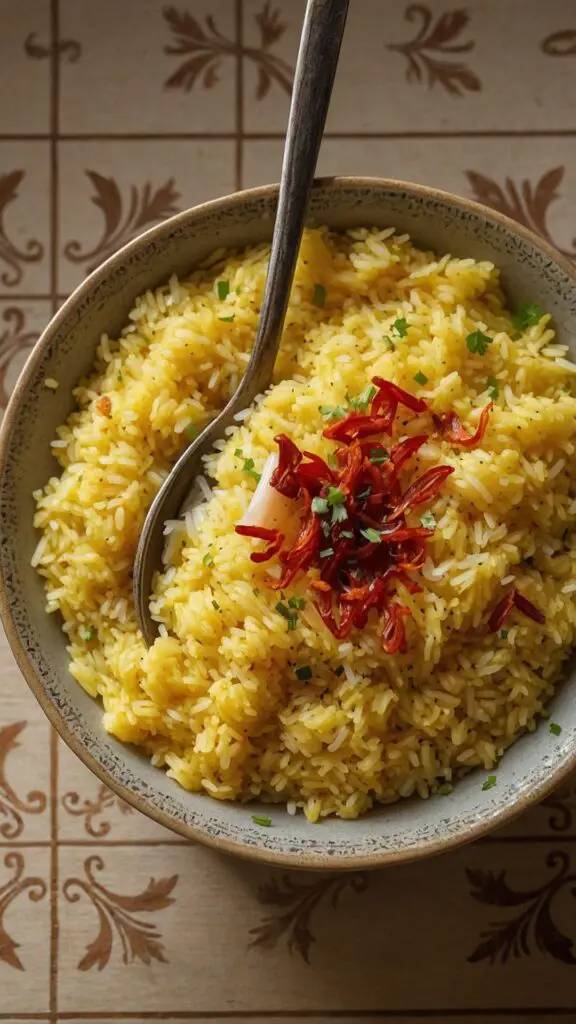
Step by Step Instructions
Step 1: Prepare the Ingredients
Start by gathering your ingredients. Rinse the basmati rice under cool water until the water runs clear. This step removes excess starch and helps achieve fluffy grains. Ensure your saffron threads are ready to use.
Step 2: Soak the Saffron
In a small bowl, combine the saffron with a couple of tablespoons of hot water. Let it sit for about 10 minutes. This soaking will release its vibrant color and flavor into the water, which will later blend with the rice.
Step 3: Sauté the Aromatics
In a medium saucepan, heat the olive oil over medium heat. Add the chopped onion and cook it until it turns translucent, about 5 minutes. Next, add the minced garlic and ground cumin. Sauté for an additional minute, allowing the flavors to meld together. The aroma at this point will already start to make your kitchen feel like a culinary haven.
Step 4: Add the Rice
Once the garlic is aromatic, add the rinsed rice. Stir gently for a couple of minutes until the rice is lightly toasted. This enhances the nutty flavor, which is essential for a well-rounded dish.
Step 5: Combine and Cook
Now, pour in the vegetable broth or water, along with the saffron and its soaking liquid. Add the lime zest and a sprinkle of kosher salt. Bring the mixture to a boil, then reduce the heat to low, and cover. Allow the rice to simmer for about 15 minutes. Patience pays off here!
Step 6: Fluff and Finish
When the cooking time is up, remove the saucepan from the heat but keep it covered for an additional 5 minutes. This resting period allows the rice to steam and achieve maximum fluffiness. Once ready, uncover and fluff the rice with a fork. Finally, stir in the chopped parsley or cilantro for a fresh pop of flavor.
Tips & Tricks
Quality Counts: Use high-quality saffron. It elevates the entire dish. Look for true saffron threads instead of powder for the best flavor.
Stock Up: Instead of plain water, use vegetable or chicken stock for added savoriness.
Make it Ahead: You can prepare saffron rice in advance. Just reheat it gently before serving.
Experiment: Feel free to add nuts like slivered almonds or pistachios for an enjoyable crunch.
Storage: Keep leftovers in an airtight container in the fridge for up to three days.
Nutrition Information
Saffron rice holds its own nutritionally. In a standard serving, it offers about 200 calories, with protein and healthy fats coming from the olive oil and any added ingredients. It’s also high in carbohydrates, giving you the energy needed throughout your day. Plus, saffron brings antioxidants, providing additional health benefits.
How Can You Store This Saffron Rice?
To keep your saffron rice fresh:
Cool Down: Allow rice to cool to room temperature before storing.
Use Airtight Containers: Place the rice in airtight containers to prevent moisture loss.
Refrigerate: Store in the fridge for up to three days.
Freezing: If you’ve made a large batch, consider freezing portions. Cool it first, then transfer it to freezer-safe bags. Frozen rice can last for up to a month.
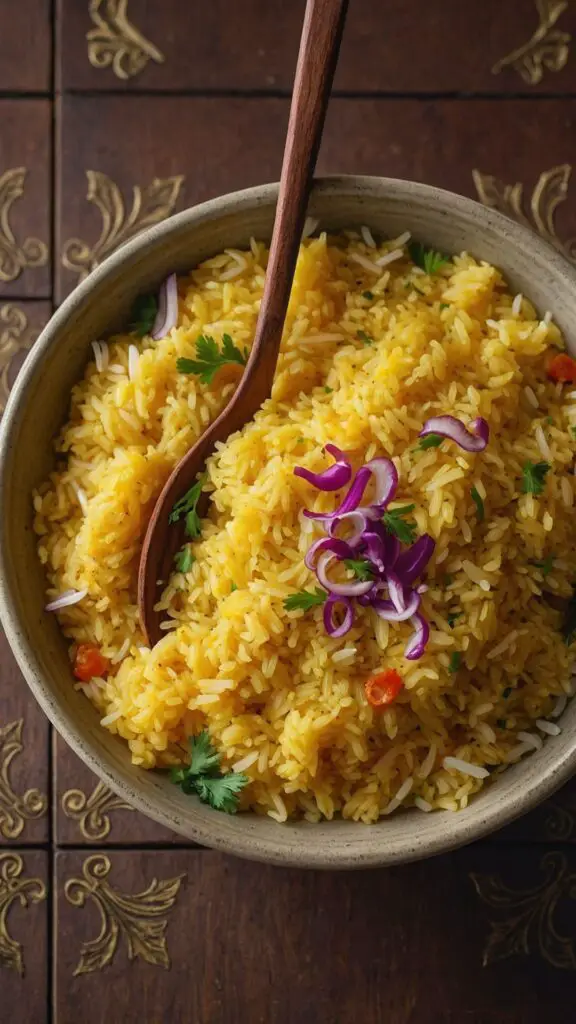
What If Some Ingredients Are Not Available?
Sometimes the pantry doesn’t cooperate. Here are alternatives to consider:
Saffron Substitute: If saffron isn’t available, you can use turmeric. It won’t replicate the exact flavor, but it offers a vibrant yellow color and earthiness.
Rice Variety: Should basmati rice be out of reach, opt for jasmine rice. It has a floral note and is quite suitable for this dish.
Lime Zest Alternatives: If you lack lime, lemon zest will work just as well. It provides a similar citrus brightness.
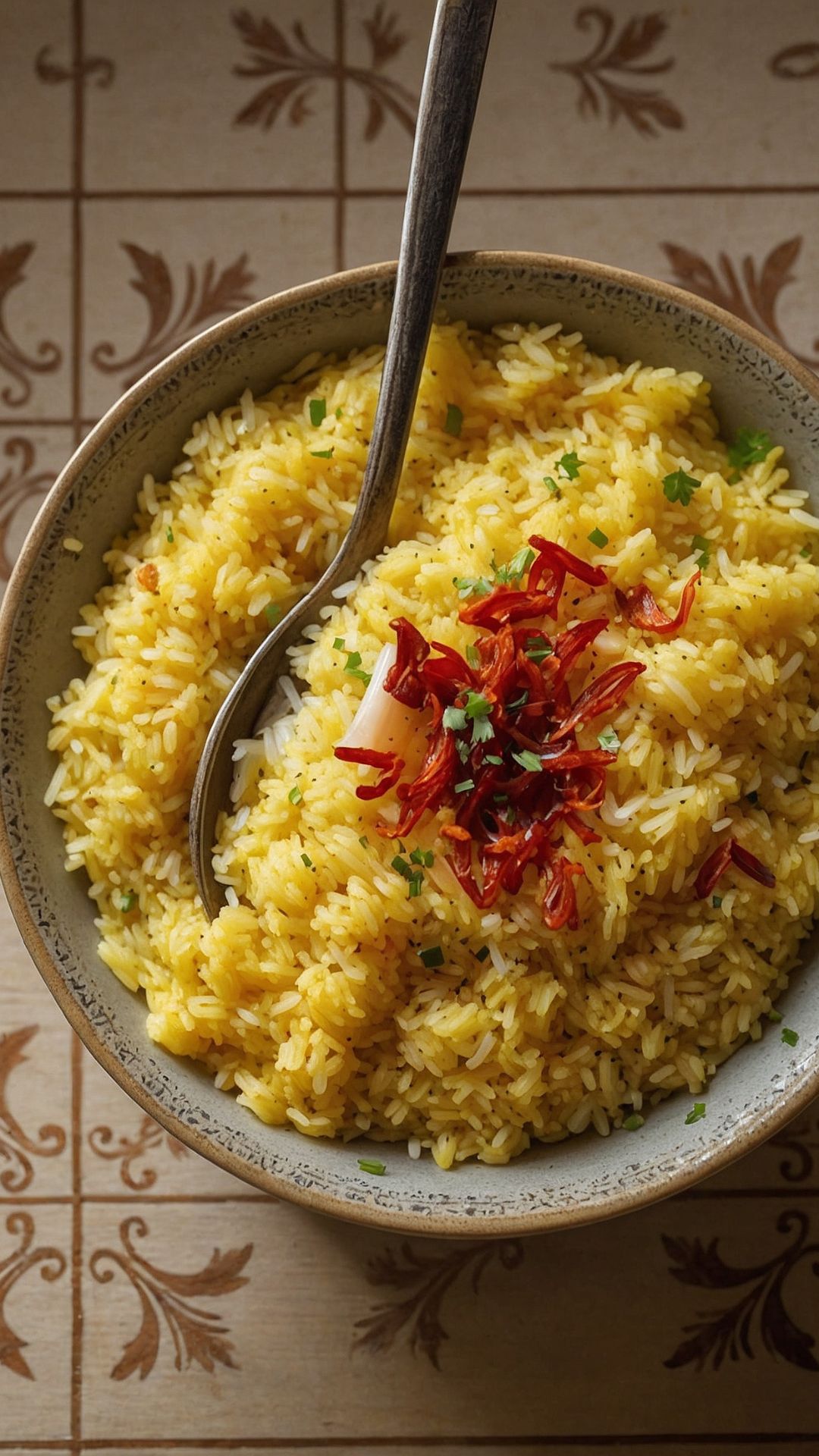
Saffron Rice Recipe
Ingredients
Equipment
Method
- Start by gathering your ingredients. Rinse the basmati rice under cool water until the water runs clear. This step removes excess starch and helps achieve fluffy grains. Ensure your saffron threads are ready to use.
- In a small bowl, combine the saffron with a couple of tablespoons of hot water. Let it sit for about 10 minutes. This soaking will release its vibrant color and flavor into the water, which will later blend with the rice.
- In a medium saucepan, heat the olive oil over medium heat. Add the chopped onion and cook it until it turns translucent, about 5 minutes. Next, add the minced garlic and ground cumin. Sauté for an additional minute, allowing the flavors to meld together. The aroma at this point will already start to make your kitchen feel like a culinary haven.
- Once the garlic is aromatic, add the rinsed rice. Stir gently for a couple of minutes until the rice is lightly toasted. This enhances the nutty flavor, which is essential for a well-rounded dish.
- Now, pour in the vegetable broth or water, along with the saffron and its soaking liquid. Add the lime zest and a sprinkle of kosher salt. Bring the mixture to a boil, then reduce the heat to low, and cover. Allow the rice to simmer for about 15 minutes. Patience pays off here!
- When the cooking time is up, remove the saucepan from the heat but keep it covered for an additional 5 minutes. This resting period allows the rice to steam and achieve maximum fluffiness. Once ready, uncover and fluff the rice with a fork. Finally, stir in the chopped parsley or cilantro for a fresh pop of flavor.
Nutrition
Notes
- Quality Counts: Use high-quality saffron. It elevates the entire dish. Look for true saffron threads instead of powder for the best flavor.
- Stock Up: Instead of plain water, use vegetable or chicken stock for added savoriness.
- Make it Ahead: You can prepare saffron rice in advance. Just reheat it gently before serving.
- Experiment: Feel free to add nuts like slivered almonds or pistachios for an enjoyable crunch.
- Storage: Keep leftovers in an airtight container in the fridge for up to three days.
Tried this recipe?
Let us know how it was!Frequently Asked Questions
1. Can I make saffron rice in a rice cooker?
Absolutely! To use a rice cooker, follow the same steps of heating oil and sautéing your aromatics. Then, mix in the rice, saffron, and liquid, and transfer everything to the rice cooker. Follow the manufacturer’s instructions for cooking times.
2. Is saffron rice gluten-free?
Yes, saffron rice is naturally gluten-free. Just ensure your other ingredients, like broth, do not contain gluten.
3. Can I add protein to saffron rice?
Definitely! You can mix in cooked chicken, shrimp, or even chickpeas to add protein. It’ll create a more hearty dish.
4. How spicy is saffron rice?
Saffron rice is not typically spicy. It plays with flavor, not heat. The cumin provides warmth, but it won’t make you reach for a glass of water.
5. What dishes can I serve with saffron rice?
Saffron rice pairs beautifully with grilled meats, such as chicken or lamb. You can also serve it alongside fish, lentil stews, or roasted vegetables.
Conclusion
Saffron rice is more than just a side dish; it is an invitation to explore flavor, color, and texture. As you prepare it, remember this: food brings people together. Each grain of rice in your dish tells a story of tradition and connection.
So, go ahead and create your own story with saffron rice. Enjoy the process, savor the flavors, and share it with loved ones. Now that you have all the tools, it’s time to get cooking!

